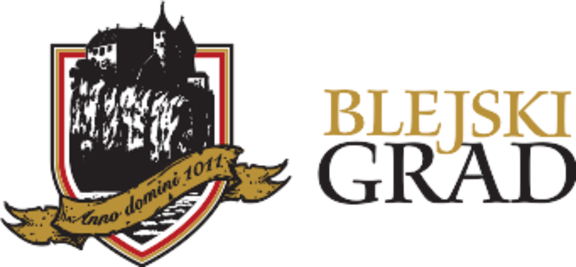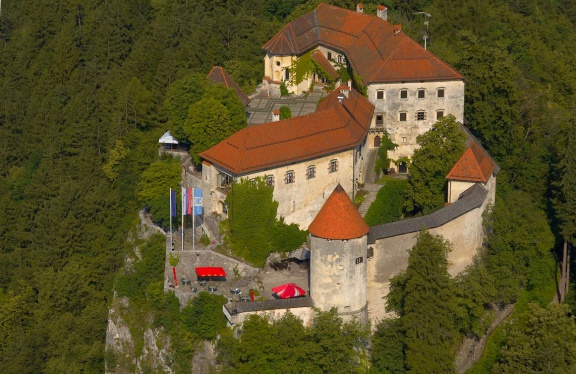Difference between revisions of "Bled Castle"
Ivan Pirnat (talk | contribs) (teaser) |
Ivan Pirnat (talk | contribs) (bistvo) |
||
| Line 31: | Line 31: | ||
{{Teaser| | {{Teaser| | ||
| − | Bled is one of Slovenia mayor tourist attractions from natural and historic point of view. Especially [[Bled Castle]] standing on the cliff towering over Lake Bled, with high Julijan Alps in the background can be seen in every brochure on Slovenia. | + | Bled is one of Slovenia mayor tourist attractions from natural and historic point of view. Especially [[Bled Castle]] standing on the cliff towering over Lake Bled, with high Julijan Alps in the background can be seen in every brochure on Slovenia. In 2004 castle celebrated 1000 years of existence since was built by the Bishops of Brixen as first mentioned in documents in year 1004. In 1511 the castle was badly damaged by an earthquake. The present look of the castle dates from the late 17th century and includes major restoration works carried out in the 1950s. Castle has since late 19th century changed many owners. Preserved from the original building are the Romanesque walls with an entrance tower and the reconstructed wooden defence corridors, while the other sections of the castle are generally in Gothic and Renaissance styles. Today premises of the castle are administered by Bled Culture Institute. There are restaurant, Printing Works, Castle Wine Cellar, Herbal Gallery, Knight's Hall with multi-visions ,Castle Chapel etc., where medieval shows, weddings, concerts, political and corporate events are taking place. Only ''Bled Castle museum exhibition on the history of Bled and its environs'' is set and maintained by [[National Museum of Slovenia]]. Museum in [[Bled Castle]] was established in [[established :: 1957]]. Exhibition was renewed and reopened in year 2008 in 14 chambers of the former residential rooms of the castle. The exhibited original artefacts (a total of some 400) and replicas that are gathered, present Geological, natural, general and art history, archaeology and construction phases of the [[Bled Castle]]. Look into Palaeontology well reveals animations with flora and fauna of fossil remains discovered in the region. How glacier shaped the landscape of mountains surrounding contemporary Bled and Bohinj and how lakes were formed, can be seen in a multi-vision projection on a huge oval relief installation. Bled with environs is Slovenia's best archaeologically researched area. This part of the museum exhibition shows numerous fund artefacts that witness the Ice Age hunters, the first Stone Age tillers and stockbreeders, the Copper, Bronze and Iron Age settlers, inhabitants from the Roman Period and Late Antiquity, Early Mediaeval and Early Slavic Period, when villages and roads, still recognized today, were built. Bled was from 11th to begining of 19th century the seat of the Bishopric of Gorenjska. In 19th century Bled developed into famous health resort thanks to strict Swiss doctor Arnold Rikli, soon clever locals opened their own spa arrangements, where more hedonism was practitioned. Big copper bath with photos of people doing group body practices, sunbathing in funny pants made of cloths, villas for rich that rose around the lake are presented on first floor. Exhibition rooms are furnished with old furniture dating mainly from 19th century. Castle toilet in one of exhibition spaces on second floor has probably the best toilet view in the world. Through small window one can see directly Bled Island with church in the middle of the lake. Toilet was made in a niche that juts out of the castle wall, what is missing is round plexi glass window that enables visitor to look through hole into abyss under. It is now unfortunately closed with wooden lid. Bled Castle events and various cultural programmes are managed by [[Bled Culture Institute]]. |
| − | |||
| − | |||
| − | |||
}} | }} | ||
| − | |||
| − | |||
| − | |||
| − | |||
| − | |||
| − | |||
| − | |||
| − | |||
| − | |||
| − | |||
| − | |||
| − | |||
| − | |||
| − | |||
==See also== | ==See also== | ||
| Line 57: | Line 40: | ||
* [[Hrušica - Museum Collection and Archaeological Park]] | * [[Hrušica - Museum Collection and Archaeological Park]] | ||
* [[National Museum of Slovenia - Metelkova]] | * [[National Museum of Slovenia - Metelkova]] | ||
| − | + | * | |
==External links== | ==External links== | ||
| − | + | * [http://www.zavod-za-kulturo-bled.si Bled Culture Institute] | |
* [http://www.narmuz-lj.si/english/01_informations/welcome.html National Museum of Slovenia website] | * [http://www.narmuz-lj.si/english/01_informations/welcome.html National Museum of Slovenia website] | ||
* [http://en.wikipedia.org/wiki/Bled_Castle Bled Castle on Wikipedia] | * [http://en.wikipedia.org/wiki/Bled_Castle Bled Castle on Wikipedia] | ||
* [http://www.burger.si/Bled/BlejskiGradENG.html Burger.si Virtual panorama of Bled Castle] | * [http://www.burger.si/Bled/BlejskiGradENG.html Burger.si Virtual panorama of Bled Castle] | ||
* [http://www.blejski-grad.si/en/about-bled-castle/ Bled Culture Institute] | * [http://www.blejski-grad.si/en/about-bled-castle/ Bled Culture Institute] | ||
| − | + | * [http://www.blejski-grad.si/en/permanent-exhibition-by-national-museum Museum exhibition on Bled Culture Institute website] | |
[[Category:Museums]] | [[Category:Museums]] | ||
[[Category:Museum collections]] | [[Category:Museum collections]] | ||
[[Category:Monuments and sites]] | [[Category:Monuments and sites]] | ||
Revision as of 01:54, 19 January 2010
See also
- National Museum of Slovenia
- Snežnik Castle Museum
- Hrušica - Museum Collection and Archaeological Park
- National Museum of Slovenia - Metelkova




